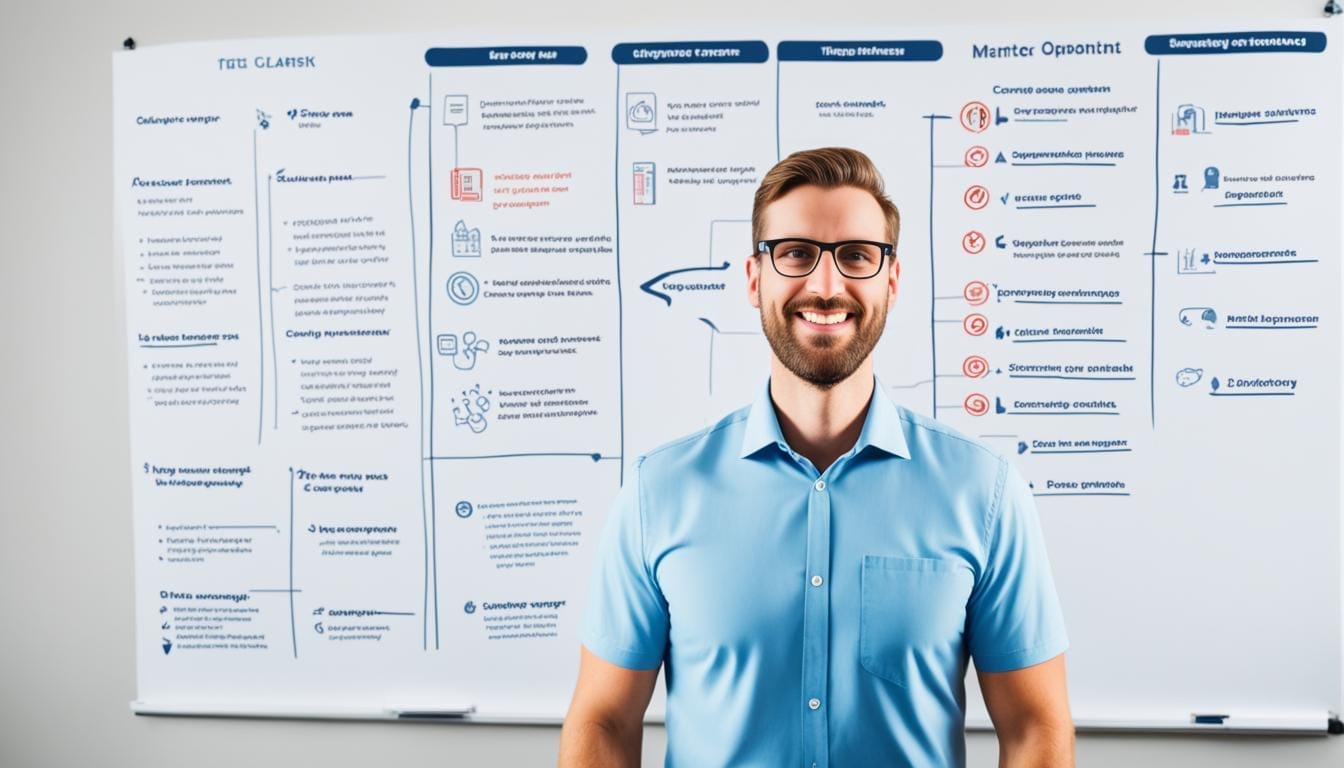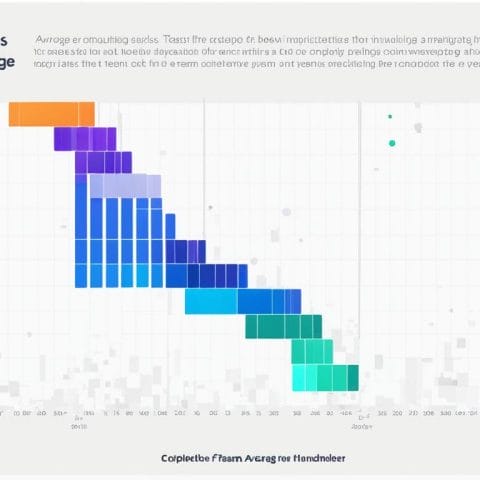Did you know 86% of employees decide to stay or leave a company in the first six months? This fact from the Aberdeen Group shows how vital a good onboarding process is. With the “Great Resignation” making headlines, making onboarding great is key.
An employee onboarding journey map shows each step of an employee’s time at a company, from start to finish. It helps businesses improve the employee experience and make onboarding smoother. By planning this journey, companies can focus on important moments, use resources wisely, and connect with new hires right away.
Having a good onboarding process brings big wins. Companies with strong onboarding keep more new hires (82%) and see a boost in productivity (70%), says the Brandon Hall Group. This shows how a well-thought-out onboarding plan helps with employee happiness and company success.
In this article, we’ll look at the five main stages of the employee onboarding journey map. We’ll see how each stage helps make the experience smooth and engaging for new hires. We’ll share best practices, what to avoid, and new ways to make sure your onboarding sets new hires up for success and loyalty.
Key Takeaways
- 86% of employees decide on long-term company commitment within six months
- Employee onboarding journey maps visualize the entire employee experience
- Strong onboarding processes improve retention by 82% and productivity by 70%
- Effective journey mapping identifies critical touchpoints and areas for improvement
- A well-designed onboarding experience significantly impacts employee engagement and loyalty
Understanding the Employee Onboarding Journey Map
An employee onboarding journey map shows the steps from getting hired to fully fitting in. It’s a tool that helps make joining a company smoother and keeps employees happy.
Definition and Importance
This map follows important moments in the new hire process. It looks at pre-boarding, the first day, the first week, and more. It helps companies see where they can do better in welcoming new people.
Benefits for Organizations and New Hires
Using a journey map has big benefits:
- Improved employee engagement from day one
- Faster time-to-productivity for new hires
- Reduced turnover rates
- Enhanced company culture alignment
For new workers, a good map gives them clear steps, support, and a feeling of belonging.
Key Components of an Effective Journey Map
A good onboarding map has:
- Clear timeline of onboarding stages
- Specific goals for each stage
- Touchpoints between new hires and the organization
- Feedback mechanisms to gather insights
- Metrics to measure success
With these parts, companies can make onboarding more engaging and successful for new hires.
The Pre-Boarding Stage: Setting the Foundation
The pre-boarding stage is key in hiring new employees. It covers everything before they start working. This stage shapes how new employees see the company.
- Time and cost to hire
- Offer acceptance rate
- Hire quality
- Job posting attractiveness
- Candidate engagement during interviews
Good pre-boarding can cut down on employee turnover by up to 20%. This stage uses user experience design to make the transition smooth from candidate to employee.
“A structured pre-boarding process can increase employee confidence by 30% before their first day.”
Here are ways to make pre-boarding positive:
- Send a welcome package with company swag
- Give access to onboarding materials early
- Introduce the new hire to their team online
- Set clear expectations for the first week
By focusing on these, companies can build a strong base for employee success and engagement.
Day One: Making a Lasting First Impression
The first day at a new job is very important. It sets the mood for the whole time they work there. A good first day can make employees want to stay and fit in better. Let’s look at what makes a first day great.
Welcome Activities and Introductions
Begin the day with a friendly welcome. Show new people who they’ll be working with and who’s important. Having a team lunch or coffee can make everyone feel more connected. This helps new people stay with the company a lot more.
Essential Paperwork and Setup
Make the paperwork easy for new employees. Have their desk ready, give them what they need, and let them into important systems. This makes it easier for them to start doing their job and feeling like part of the team.
Company Culture Immersion
Teach new employees about your company’s values, goals, and culture. This could be through a short talk, a welcome kit, or a tour for those working from home. Showing them the culture early helps them feel they belong.
| Day One Activity | Impact on Employee Retention |
|---|---|
| Structured welcome program | 82% improvement |
| Efficient paperwork process | 70% increase in productivity |
| Culture immersion activities | 25.3% boost in engagement |
A good first impression is key to success. By focusing on these areas, you’ll make the onboarding smooth and supportive. This helps keep employees happy and engaged from the start.
Week One: Establishing Role Clarity and Expectations
The first week of a new job is very important. It sets the mood for the whole time they work there. A good onboarding process can make employees happier and more likely to stay.
During this week, help new employees understand their job and its place in the company. Give them clear job descriptions and set goals that match the company’s goals. This makes them feel more sure and involved right away.
Meet important people in the team to help them connect and feel supported. Feeling part of a team is key to being happy at work. Regular meetings and feedback help solve problems and make sure everyone knows what’s expected.
“Understanding the current onboarding culture through journey mapping can help identify areas of improvement for new hires.”
Here’s a plan for a better onboarding in the first week:
| Day | Focus Area | Activities |
|---|---|---|
| Monday | Role Overview | Job description review, goal setting |
| Tuesday | Team Integration | Meet key colleagues, department tour |
| Wednesday | Systems Training | IT setup, software introductions |
| Thursday | Project Familiarization | Current project briefings, task assignments |
| Friday | Feedback and Planning | First-week review, next steps discussion |
By focusing on making things clear and setting expectations early, companies can build a strong base. This leads to happier employees and better work engagement over time.
The First Month: Building Connections and Knowledge
The first month of new hire orientation is very important. It’s all about making strong connections and learning a lot. This time is for new employees to join the team, get trained, and feel supported in their jobs.
Team Integration Strategies
Getting new employees to feel like part of the team is crucial for their happiness. Companies can use buddy systems, team activities, and social events to help them meet others. These things make new hires feel they belong and work better together.
Training and Development Initiatives
It’s key to give new employees the skills and knowledge they need. This includes:
- Role-specific technical training
- Company policies and procedures
- Industry-specific knowledge sessions
- Soft skills development workshops
Regular Check-ins and Feedback Sessions
It’s important to meet often with new hires and their managers. These meetings help talk about any issues and give advice. They make sure everyone is on the same page. Here’s a table to keep track of new employees:
| Week | Check-in Focus | Feedback Type |
|---|---|---|
| Week 1 | Initial impressions and concerns | Verbal feedback |
| Week 2 | Role clarity and expectations | Written performance review |
| Week 3 | Progress on initial tasks | 360-degree feedback |
| Week 4 | Long-term goals and career aspirations | Self-assessment and manager evaluation |
By focusing on these areas in the first month, companies can lay a strong foundation. This helps with keeping employees happy and successful over time.
Months 2-3: Fostering Independence and Growth

The onboarding process doesn’t stop after the first month. Months 2-3 focus on making employees more independent and helping them grow. This is key for keeping employees and their success over time.
Companies that care about growing their employees do well. Research shows that 73% of employers know how important it is to help employees grow. But, only 49% of employees feel their leaders really support this.
To keep employees happy and involved, try these ideas:
- Conduct performance evaluations
- Offer skill-building opportunities
- Provide targeted training interventions
- Encourage independent project ownership
Using these methods can bring big wins. Companies with strong onboarding see a 77% jump in productivity. By focusing on growth and independence, you help new hires become fully part of your team and invested in their future.
| Strategy | Impact on Employee Retention |
|---|---|
| Regular check-ins | 64% improvement |
| Clear definition of success | 68% boost in motivation |
| Gradual work introduction | 76% increase in engagement |
| Senior leader involvement | 55% higher engagement level |
By investing in your employees’ growth at this key time, you’re doing more than just onboarding. You’re building a strong foundation for their long-term success and loyalty.
Creating a Customized Onboarding Experience
A tailored onboarding journey makes employees happier and more engaged. By using design principles, companies can make a path just for each new hire.
Tailoring the Journey to Different Roles
Every job needs its own way of training. HR teams can make training that fits each role. This helps new employees fit in quicker and feel important right away.
Incorporating Employee Feedback
It’s key to listen to what employees say to make onboarding better. Surveys and regular meetings help companies know what changes to make. This keeps the onboarding process positive and right for everyone.
Leveraging Technology for Personalization
Technology and AI can make onboarding more personal. They can send content just for the employee, track progress, and help when needed.
| Onboarding Element | Customization Approach | Impact on Employee Experience |
|---|---|---|
| Welcome Kit | Personalized with role-specific items | Increases sense of belonging |
| Training Schedule | Tailored to individual learning pace | Improves knowledge retention |
| Mentor Assignment | Matched based on skills and interests | Enhances professional growth |
Creating a customized onboarding experience really helps companies. It leads to more engaged employees, quicker integration, and more people staying with the company.
Measuring Onboarding Success: Key Metrics and KPIs

It’s key to track the right metrics to see how well your onboarding works and to get better at hiring. Let’s look at some important KPIs that show how well your team is doing.
New hire satisfaction is a key metric. You can find this out through interviews and surveys that people don’t share their names on. The Net Promoter Score (NPS) shows if new employees would suggest your company to others based on how they felt during onboarding.
Retention rates are also very important. To figure this out, take the number of new hires who stay for at least 18 months and divide it by the total number of new hires. This tells you if your onboarding is working well over time.
How fast new hires start doing their job well is key too. Track how many days it takes for them to get up to speed. A shorter time means your onboarding is doing a good job.
| Metric | Formula | Importance |
|---|---|---|
| New Hire Voluntary Turnover Rate | (Number of new hires leaving voluntarily / Total new hires) x 100 | Indicates satisfaction and engagement |
| Training Completion Rate | Number of new hires completing training / Total new hires | Measures onboarding effectiveness |
| User Activation Rate | Number of activated users / Total new users | Shows initial engagement success |
By keeping an eye on these metrics, you can find out where to get better at onboarding. This helps make your hiring strategy stronger.
Common Challenges in the Onboarding Journey
The process of onboarding new employees can be tricky. It often faces many hurdles that affect how new hires feel. Let’s look at some big challenges that companies see during this key time.
Information Overload
New employees often get hit with too much information at once. A study showed that 58% of companies give too much info during onboarding. This can cause confusion and make it hard to remember important details.
Lack of Social Integration
It’s important for new employees to make friends at work. But, 31% of people leave a job in the first six months because they don’t feel connected. This is a big problem in remote or hybrid jobs, where meeting people in person is hard.
Misaligned Expectations
When the job doesn’t match what was promised, people can get unhappy fast. A survey found that 43% of new hires felt their daily tasks were different from what they were told. This can really hurt job satisfaction and how well people do their jobs.
“A well-mapped employee journey helps identify areas of discontent early on, leading to a reduction in turnover and related costs.”
To beat these challenges, companies need to make onboarding better. This means giving new hires the right amount of info, helping them connect with others, and making sure they know what to expect at their job. By fixing these issues, companies can make the work experience better and help employees succeed over time.
Best Practices for Continuous Improvement
Having a good onboarding process is key to keeping employees happy and successful over time. Companies that focus on making their onboarding better see big wins. For example, a strong onboarding program can make new hires 70% more productive and keep 82% of them.
To keep your onboarding up to date and effective, ask new hires what they think often. Use surveys to make the experience better and smoother. These surveys help cut HR costs and make employees happier and more loyal. Remember, 78% of leaders think making employees happy is key to reaching business goals.
Use data to find out what’s working and what’s not in your onboarding. Look at how long people stay, why they leave, and what they say in exit interviews. If new hires leave after just a month, it might mean the onboarding needs work. Fixing this can make your team 20% more productive and keep 70% of employees for three years or more.
Think of onboarding as a process that changes as your company does. Offer training to keep 94% of employees excited and motivated. By following these tips, you’ll make onboarding a journey that helps both new employees and your company grow.
FAQ
Q: What is an employee onboarding journey map?
A: An employee onboarding journey map shows each step of an employee’s time at a company. It covers from recruitment to exit. This map helps companies focus on what matters most.
Q: What are the benefits of an employee journey map?
A: It makes the employee’s experience clear. It shows where to improve. It helps make job descriptions better and guides budget for keeping employees happy.
Q: What are the key components of an effective employee journey map?
A: Important parts include knowing who the employees are, the steps they go through, getting feedback, and measuring progress the same way at each step.
Q: What are the considerations in the pre-boarding stage?
A: In pre-boarding, think about how long and costly hiring is, how many accept the offer, how good the hires are, how appealing the job is, and how engaged candidates are during interviews.
Q: What activities typically occur on Day One of the onboarding process?
A: On Day One, new hires get their equipment and access to important systems. They go on office tours, do mandatory training, get company items, have team lunches, and meet leaders.
Q: What is the focus during the first week of onboarding?
A: The first week helps new hires understand their job and what’s expected. They learn about their role, set goals, and meet important people in their team.
Q: What are the key activities during the first month of onboarding?
A: The first month is for building connections and learning more. It includes deep training, team activities, and regular meetings with managers.
Q: What is the focus during months 2-3 of the onboarding process?
A: Months 2-3 focus on making new hires more independent and growing. They include checking on performance, learning new skills, and getting training.
Q: How can organizations create a customized onboarding experience?
A: Companies can make the journey fit different roles by using feedback and technology. This includes digital onboarding and AI tools for a personal touch.
Q: What are some common challenges in the onboarding journey?
A: Challenges include too much information, not feeling part of the team, and having wrong expectations about the job.
Q: What are some best practices for continuous improvement of the onboarding process?
A: Good practices are to always use employee feedback, update the process as needed, and use data to find areas to improve.





